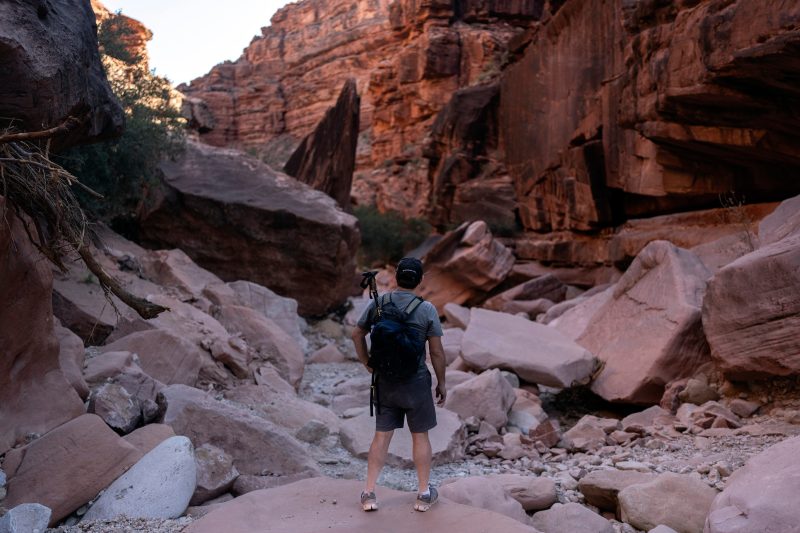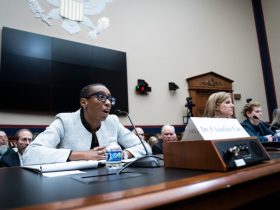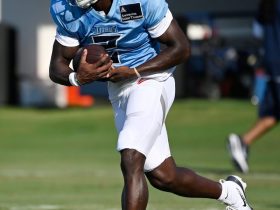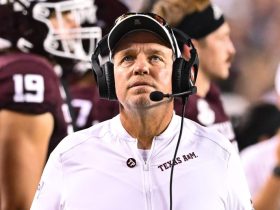SUPAI, Ariz. — Rep. Ruben Gallego arrived at the bottom of the Grand Canyon barefoot, shoes in hand, after crossing a stream during a 2,000-foot descent.
The 44-year-old Marine Corps veteran, five-term Democratic congressman and U.S. Senate candidate had started the eight-mile hike in darkness. Now, under the midday sun, he was approaching a Havasupai village that is only accessible by foot, mule, horse or helicopter.
Arizona is home to 22 federally recognized tribes, and Gallego, who is acutely aware that Native voters helped deliver this closely divided state to President Joe Biden in 2020, is trying to visit all of them in the final stretch of a race that could determine control of the Senate.
The Havasupai were 20th on Gallego’s list. When he reached Supai village on the morning of Indigenous Peoples’ Day, trailed by 15 reporters, aides and tribal liaisons, he was embraced by Felicia Siyuja, a tribal council member, who made clear she was happy to see that he had opted to skip the chopper ride.
“You walked in our people’s shoes when you hiked down,” another tribal council member, Juanita Wescogame, later told Gallego.
Perhaps no swing-state politician in America has made more of an effort to reach out to tribal communities than Gallego, who faces former local TV host Kari Lake, a Republican ally of Donald Trump, in November’s election.
His trek demonstrates how critical both major parties now believe the votes of people in Arizona’s tribal communities, who make up 4.5 percent of the state’s population, could be in a close race. The parties have invested time and money in trying to win their votes, with the Republican National Committee sending GOP staffers to meet with Navajo representatives weekly, among other outreach efforts.
In his seven-hour visit to Supai, Gallego danced with tribal members, ate their fry bread tacos, toured recent flooding damage and listened to their concerns about the impact of uranium mining on their land and people.
Gallego’s tour of the tribes began more than a year and a half ago, when he made the Navajo Nation one of his campaign’s first stops. In an interview Monday, Gallego said tribal voters “always do feel that Democrats only show up for the last two weeks, and I wanted to make sure that we were here from Day 1.”
Native Americans have long felt overlooked in electoral politics and disillusioned with both parties. In Supai, far from the vote-rich Phoenix area, the feeling can be even more pronounced.
“I want them to know that there’s actually people living in the bottom of the Grand Canyon,” Armando Marshall, vice chairman of the Havasupai Tribe, said when asked for his message to the outside world.
Attention undoubtedly increased after the 2020 election, when Biden won Arizona by just 10,457 votes.
“When you’re talking about [that margin] being the difference between victory and not, you can’t afford not to hike down to Supai,” said Clara Pratte, who was the Biden campaign’s tribal engagements director.
Gallego arrived in Supai, on a reservation that is home to about 200 people, according to the 2020 census, weeks after flash flooding devastated the community. It caused the evacuation of scores of hikers, among the thousands who flock to the area annually to see the idyllic waterfalls from which the Havasupai Tribe — “people of the blue-green waters” — gets its name. Hikers can wait years to land a coveted permit to hike to the falls.
On the trail, there were few obvious signs of the flooding, and Gallego was struck by how quickly workers were able to make the route passable again for the tourists who power the village economy.
Tribal leaders were far more concerned about a longer-running issue: the uranium mining that they say threatens the spring-fed creek winding through their village.
When Gallego entered the village, he was greeted by a large red sign with a radioactive waste logo, reading, “NO! URANIUM MINING.” He later joined hands with tribal members in a circle and danced to a uranium mining protest song.
The community has long opposed the Pinyon Plain Mine, outside Grand Canyon National Park, and although Biden moved last year to protect the area from additional mining, they remain focused on the existing mine and the risk of water contamination.
Addressing Gallego and his group at the center of Supai, Siyuja rattled off all the things that the water allows the tribe to grow — cherries, grapes, apricot, corn. Visitors, she said, have told her they could find all the salad ingredients they would ever need in the village.
Wescogame pleaded with Gallego to “find a loophole” to stop the mine.
“The uranium mining does need to be halted,” Gallego said during a speech at the center of the village. “It is much too dangerous for the Havasupai people.”
As the tribal leaders recognized Gallego for aligning with them against the mine — “so far,” one specified — they offered support for his Senate bid.
“I’m not a Democrat. I’m not a Republican. I’m independent, but I do vote, and you have my support,” Marshall told Gallego inside the council chambers.
Marshall, in an interview earlier, lamented that Lake was “more Trump-style” and more focused on the border in her campaign.
Lake’s campaign says it considers the Native vote “of critical importance.” Mike Woestehoff, chair of Native Americans for Kari, said in a statement that the campaign is working to show tribal communities “they have real options, and we won’t take their vote for granted.”
Lake has made several trips to reservations in her campaign and organized at least two roundtables on Native issues. After an August visit to the Navajo Nation, Lake gained the endorsement of the tribe’s former vice president, Myron Lizer.
Lizer is a Republican, though he said Lake had to earn his support. She made her case to Lizer and his wife over a 30-minute phone call, during which Lizer admonished her for missing a major Navajo parade when she was running for governor in 2022. He said he would only endorse her if she came to the nation — and she did, attending a rodeo in June.
“I’ve seen us voting Democratic for five decades, and nothing’s changed in Indian country,” said Lizer, who is also starring in radio ads for the Arizona GOP. “I want to give Republican leadership another opportunity to enhance life here.”
In the presidential race, Vice President Kamala Harris’s campaign has hired 22 organizers for tribal outreach in this state alone, with plans to add nine more before the election, according to the campaign. Among its top surrogates to tribal voters is Peggy Flanagan, Minnesota’s lieutenant governor, who is the highest-ranking Native woman to hold executive office in the country.
Minnesota’s governor and Harris’s running mate, Tim Walz, visited the Phoenix area this month to meet with tribal leaders, predicting that a “Native wall” in Arizona and other states would deliver victory for her this fall.
The Democratic National Committee says it is spending more than ever this election targeting Native voters. It marked Indigenous Peoples’ Day by announcing a six-figure ad campaign aimed at tribal communities in Arizona and three other states. The Harris campaign also on Monday announced TV and radio ads “in and around” the Navajo Nation.
In their messaging, Democrats are emphasizing their broad commitment to tribal sovereignty, while Republicans are looking to tap into concerns about the economy.
Republican staffers meet with Navajo voters on a weekly basis, according to an RNC spokesperson. The RNC, working with Donald Trump’s campaign, has sent staff and volunteers to events on reservations such as flea markets and rodeos.
Trump himself has made personal appeals to Native voters, giving a shout-out to Tanya Lewis, chairwoman of the Yavapai-Apache Nation, during a rally Sunday in Prescott Valley, Ariz. Lewis helped show Gallego around when he visited her reservation in the spring.
Bernadine Jones, chairwoman of the Havasupai Tribe, told reporters she has heard “nothing at all” from Trump or Lake and did not personally know any tribal members supporting them.
While the Native vote tends to lean Democratic, some communities have long been skeptical of both parties. Jaynie Parrish, the founder of Arizona Native Vote, said she did not register to vote until her late 20s, thinking politics was just “a place for greedy White men.”
Biden’s 2020 margin in Arizona was a turning point, Parrish said, but so was what he did next: pick Rep. Deb Haaland (D) of New Mexico to lead the Interior Department, making her the first Native American Cabinet secretary in American history.
Parrish now cites the 2020 numbers to tell reluctant voters: “Look at them: Your vote mattered.”
“There’s definitely a vying now,” Parrish added.
Pratte, the former Biden campaign tribal outreach director, said that as the election nears, in addition to consistently showing up, candidates need to be mindful that tribal members tend to be “day-of voters.” Among other things, she noted, they value the communal experience of in-person voting.
Gallego’s visit was somber at times, such as when the tribal leaders shared their frustrations with government. But he also happily obliged when they showed off the natural beauty of the reservation. The congressman was among the first in his group to reach the base of Havasu Falls, peeling off his shirt and jumping into the misty waters.
Drying off afterward, Gallego quipped to reporters, “My next town hall is going to be so disappointing when you cover it.”
On the way out Monday, Gallego and his crew opted for a helicopter ride, sparing themselves the uphill climb.
Karin Brulliard contributed to this report.








